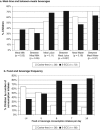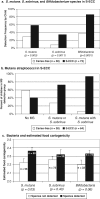Diet and caries-associated bacteria in severe early childhood caries
- PMID: 20858780
- PMCID: PMC2954266
- DOI: 10.1177/0022034510376543
Diet and caries-associated bacteria in severe early childhood caries
Abstract
Frequent consumption of cariogenic foods and bacterial infection are risk factors for early childhood caries (ECC). This study hypothesized that a short diet survey focused on frequency of foods, categorized by putative cariogenicity, would differentiate severe ECC (S-ECC) from caries-free children. Children's diets were obtained by survey and plaque bacteria detected by PCR from 72 S-ECC and 38 caries-free children. S-ECC children had higher scores for between-meal juice (p < 0.01), solid-retentive foods (p < 0.001), eating frequency (p < 0.005), and estimated food cariogenicity (p < 0.0001) than caries-free children. S-ECC children with lesion recurrence ate fewer putative caries-protective foods than children without new lesions. Streptococcus mutans (p < 0.005), Streptococcus sobrinus (p < 0.005), and Bifidobacteria (p < 0.0001) were associated with S-ECC, and S. mutans with S. sobrinus was associated with lesion recurrence (p < 0.05). S. mutans-positive children had higher food cariogenicity scores. Food frequency, putative cariogenicity, and S. mutans were associated with S-ECC individually and in combination.
Figures


Comment in
-
Diet may be Associated with the Detection of Cariogenic Bacteria in Children with Early Childhood Caries.J Evid Based Dent Pract. 2011 Sep;11(3):153-5. doi: 10.1016/j.jebdp.2011.06.015. J Evid Based Dent Pract. 2011. PMID: 21855819 No abstract available.
Similar articles
-
Quantitative real-time polymerase chain reaction for Streptococcus mutans and Streptococcus sobrinus in dental plaque samples and its association with early childhood caries.Int J Paediatr Dent. 2009 Mar;19(2):141-7. doi: 10.1111/j.1365-263X.2008.00942.x. Int J Paediatr Dent. 2009. PMID: 19250396
-
Microbiota of severe early childhood caries before and after therapy.J Dent Res. 2011 Nov;90(11):1298-305. doi: 10.1177/0022034511421201. Epub 2011 Aug 25. J Dent Res. 2011. PMID: 21868693 Free PMC article.
-
Streptococcus mutans and Streptococcus sobrinus colonization and caries experience in 3- and 5-year-old Thai children.Clin Oral Investig. 2015 Nov;19(8):1955-64. doi: 10.1007/s00784-015-1437-0. Epub 2015 Mar 11. Clin Oral Investig. 2015. PMID: 25753978 Free PMC article. Clinical Trial.
-
Cariogenicity depends more on diet than the prevailing mutans streptococcal species.J Dent Res. 1996 Jan;75(1):535-45. doi: 10.1177/00220345960750010501. J Dent Res. 1996. PMID: 8655757 Review.
-
[The role of Streptococcus mutans in human caries].Minerva Stomatol. 1990 May;39(5):413-29. Minerva Stomatol. 1990. PMID: 2199814 Review. Italian.
Cited by
-
Beyond Streptococcus mutans: dental caries onset linked to multiple species by 16S rRNA community analysis.PLoS One. 2012;7(10):e47722. doi: 10.1371/journal.pone.0047722. Epub 2012 Oct 16. PLoS One. 2012. PMID: 23091642 Free PMC article.
-
l-Arginine Modifies the Exopolysaccharide Matrix and Thwarts Streptococcus mutans Outgrowth within Mixed-Species Oral Biofilms.J Bacteriol. 2016 Sep 9;198(19):2651-61. doi: 10.1128/JB.00021-16. Print 2016 Oct 1. J Bacteriol. 2016. PMID: 27161116 Free PMC article.
-
Effect of a Tea Polyphenol on Different Levels of Exposure of Nicotine and Tobacco Extract on Streptococcus mutans Biofilm Formation.Front Oral Health. 2021 Dec 1;2:737378. doi: 10.3389/froh.2021.737378. eCollection 2021. Front Oral Health. 2021. PMID: 35048053 Free PMC article.
-
The Associations between Snack Intake and Cariogenic Oral Microorganism Colonization in Young Children of a Low Socioeconomic Status.Nutrients. 2024 Apr 10;16(8):1113. doi: 10.3390/nu16081113. Nutrients. 2024. PMID: 38674804 Free PMC article.
-
Salivary proteins and microbiota as biomarkers for early childhood caries risk assessment.Int J Oral Sci. 2017 Nov 10;9(11):e1. doi: 10.1038/ijos.2017.35. Int J Oral Sci. 2017. PMID: 29125139 Free PMC article. Review.
References
-
- Aligne CA, Moss ME, Auinger P, Weitzman M. (2003). Association of pediatric dental caries with passive smoking. JAMA 289:1258-1264 - PubMed
-
- Almeida AG, Roseman MM, Sheff M, Huntington N, Hughes CV. (2000). Future caries susceptibility in children with early childhood caries following treatment under general anesthesia. Pediatr Dent 22:302-306 - PubMed
-
- Arcella D, Ottolenghi L, Polimeni A, Leclercq C. (2002). The relationship between frequency of carbohydrates intake and dental caries: a cross-sectional study in Italian teenagers. Public Health Nutr 5:553-560 - PubMed
-
- Bankel M, Eriksson UC, Robertson A, Köhler B. (2006). Caries and associated factors in a group of Swedish children 2-3 years of age. Swed Dent J 30:137-146 - PubMed
Publication types
MeSH terms
Grants and funding
LinkOut - more resources
Full Text Sources
Medical
Research Materials

